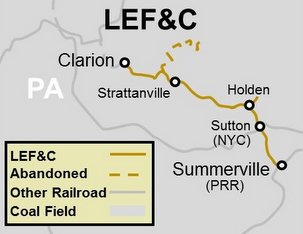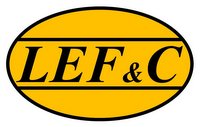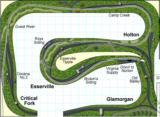| Track Plans | Photos
|
Models
(no models at this time) |
History
 The Lake Erie, Franklin and Clarion’s roots go back to 1903 when the Pittsburgh, Summerville and Clarion Railroad started building its line from a connection with the Pennsylvania Railroad at Summerville, PA to the town of Clarion, about 15 miles northwest. Clarion was originally served by a narrow gauge branch of the Buffalo, Rochester & Pittsburgh (B&O), but the BR&P’s line was abandoned after residents refused to pay the railroad for repairs to a spindly trestle critical to the line, paving the way for a new railroad to serve the town. The treasure initially sought in this area was timber, but in the early 1900s, it became apparent that the area’s coal was the commodity in demand. A second interchange on the south end was opened up at Sutton with the Lake Shore & Michigan Southern, later the New York Central. A branch was also built from Strattanville up Mills Creek and it’s rich timber, but this line was plagued by tight curves and was abandoned in )____. In 1912, the railroad was reorganized as the Pittsburgh, Clarion & Franklin Railroad, and in 1913, the line was merged with the Pennsylvania Northern and Pennsylvania Southern which owned portions of the line’s property to form the Lake Erie, Franklin and Clarion, a lofty title including two areas never served by the LEF&C. At its high point, the LEF&C operated about 32 miles of track including branches.
The Lake Erie, Franklin and Clarion’s roots go back to 1903 when the Pittsburgh, Summerville and Clarion Railroad started building its line from a connection with the Pennsylvania Railroad at Summerville, PA to the town of Clarion, about 15 miles northwest. Clarion was originally served by a narrow gauge branch of the Buffalo, Rochester & Pittsburgh (B&O), but the BR&P’s line was abandoned after residents refused to pay the railroad for repairs to a spindly trestle critical to the line, paving the way for a new railroad to serve the town. The treasure initially sought in this area was timber, but in the early 1900s, it became apparent that the area’s coal was the commodity in demand. A second interchange on the south end was opened up at Sutton with the Lake Shore & Michigan Southern, later the New York Central. A branch was also built from Strattanville up Mills Creek and it’s rich timber, but this line was plagued by tight curves and was abandoned in )____. In 1912, the railroad was reorganized as the Pittsburgh, Clarion & Franklin Railroad, and in 1913, the line was merged with the Pennsylvania Northern and Pennsylvania Southern which owned portions of the line’s property to form the Lake Erie, Franklin and Clarion, a lofty title including two areas never served by the LEF&C. At its high point, the LEF&C operated about 32 miles of track including branches.
The LEF&C offered passenger service between Clarion and Summerville until 1942 and also Franklin, PA via trackage rights over the NYC until 1924. In the 1930s and ’40s, the LEF&C was home to several coal loaders and was operated with a fleet of 5-6 ex-Bessemer & Lake Erie steam locomotives. The LEF&C ordered its first diesels in 1949, a pair of Alco RS1s, and the line was completely dieselized in 1950. Coal traffic ebbed and flowed, but the LEF&C had many more years operating in the black than the red. Coal tonnage was augmented by a few local industries including a glass plant at Clarion, a brick plant at Summerville, an explosives distributor, two lumber yards and a mattress factory. Additionally, the LEF&C had fleet of several hundred hoppers and later boxcars, and it earned sizable per-diem revenue. Interchange partners changed over the years as the NYC and PRR merged into the Penn Central and later Conrail. In the 1990s, the Pittsburg & Shawmut‘s owner purchased the former NYC line through Sutton and operated it as the Mountain Laurel Railroad. In the 1990s, the LEF&C was down to just one coal loader, and once that operation shut down around 1993, so did the LEF&C.
Coal Lines and Operations
During the diesel era, the LEF&C consisted essentially of a single line with a few loaders along it from Strattanville to Holden. The number of loaders ranged from one to four during this era. During the early 1960s, the LEF&C had three RS1s, one active loader and ran two trains daily in the afternoon and evening. Trains started at Clarion (home of the engine house and offices) picking up cars from local industries and loaded coal hoppers along the way, interchanging with the NYC and PRR at Sutton and Summerville, and dropping empty hoppers and cars at industries on the trip back to Clarion. Coal traffic picked up in the 1970s, necessitating an upgrade to EMD SW1500 and later MP15DC locomotives. This increase in motive power allowed the LEF&C to run multiple trains daily to work all the loaders, but the pattern was likely the same, pick up cars from Clarion to Summerville, drop off cars from Summerville to Clarion.
LEF&C Diesel Roster
| Number | Model | Origin |
| 20-22 | RS1 | 20-21 new 1949-50, 22 ex-M&StL |
| 23-24 | SW1500 | new 1971-72 |
| 25-28 | MP15DC | new 1976-79 |
Related Products:
Sources:
- Brown, James. “A History of the Lake Erie, Franklin and Clarion Railroad”
- “Lake Erie, Franklin and Clarion Railroad.” American-Rails.com
- Saylor, Roger. The Railroads of Pennsylvania. 1964






 LEF&C Track Plans
LEF&C Track Plans